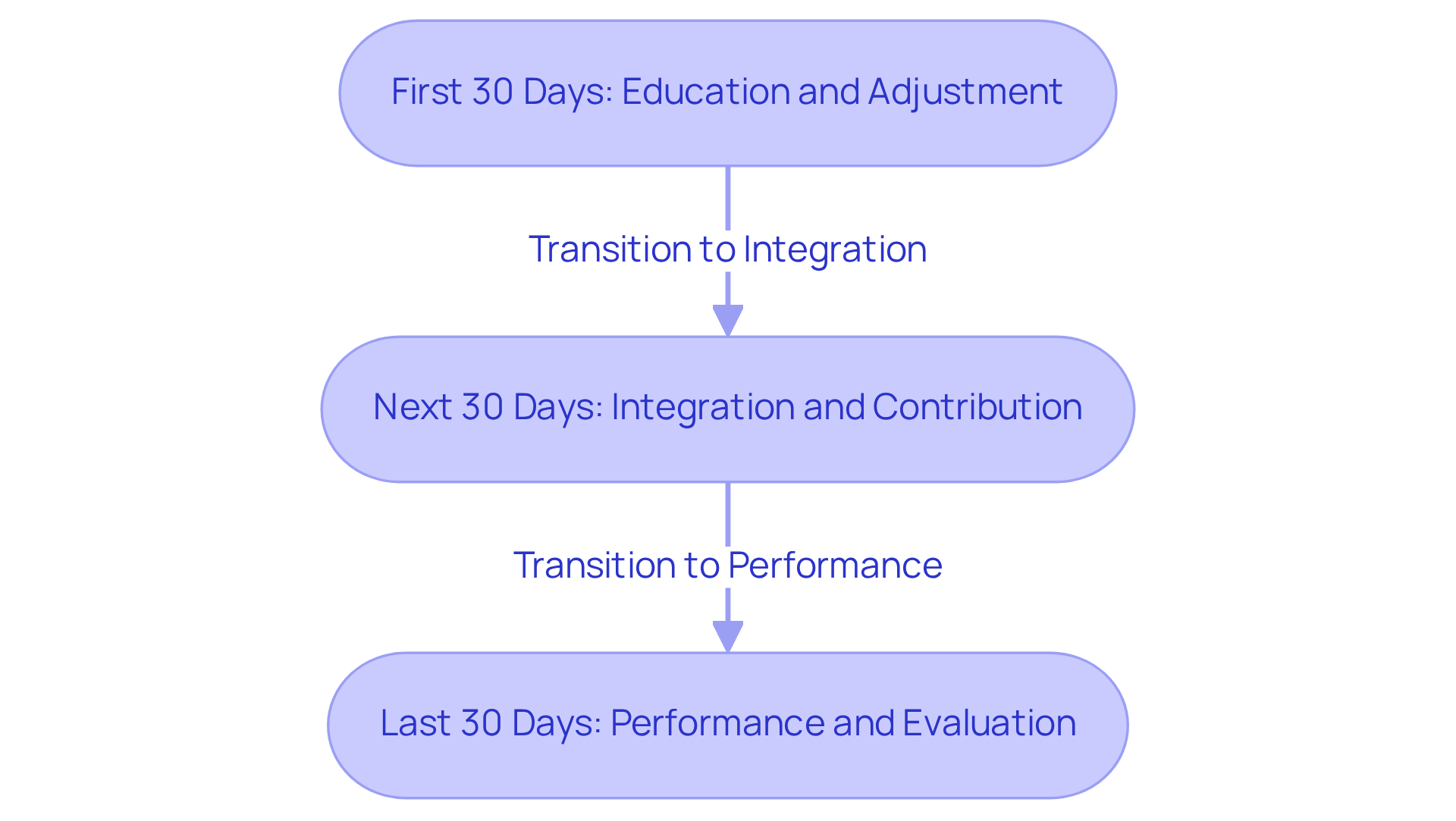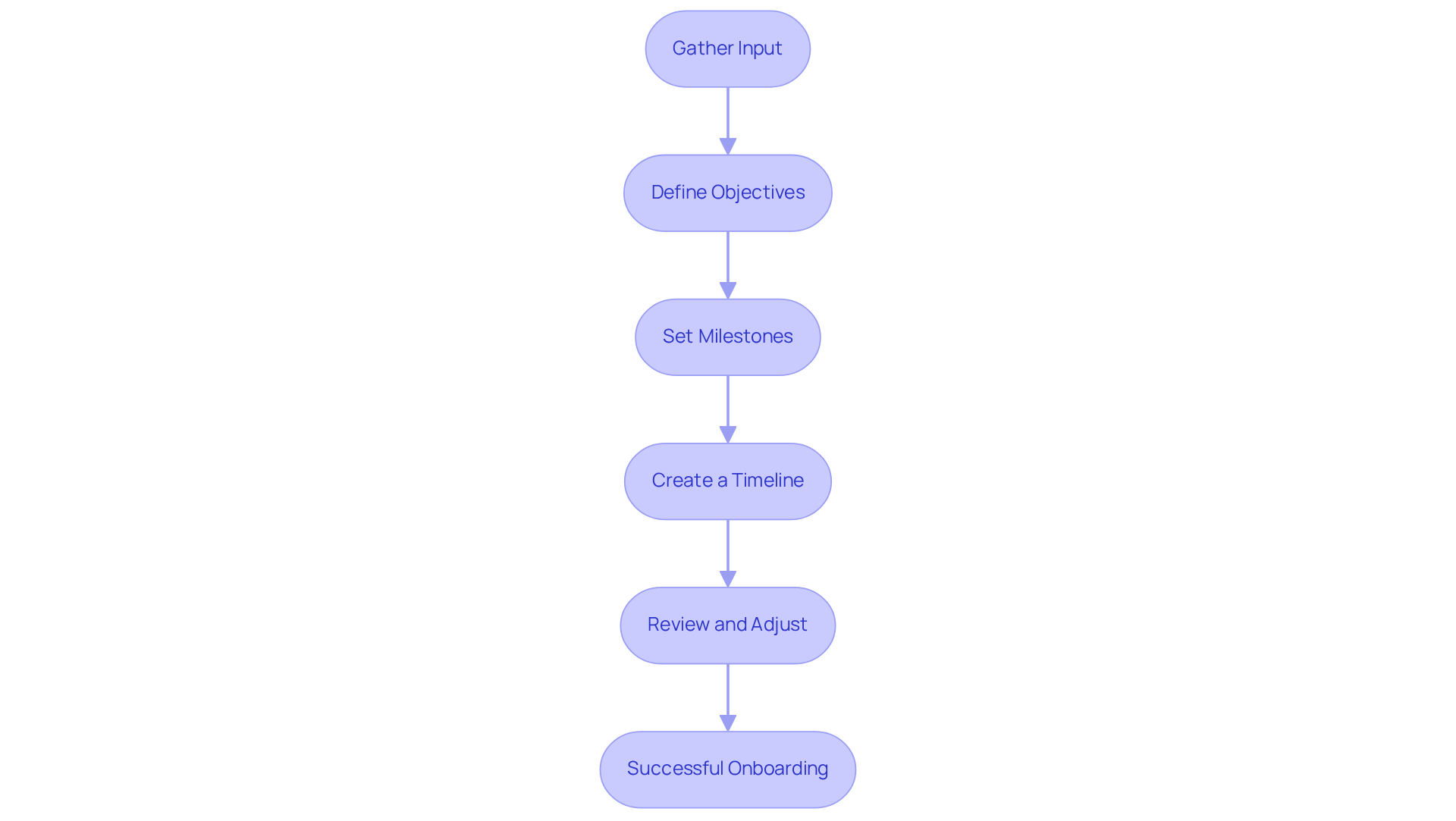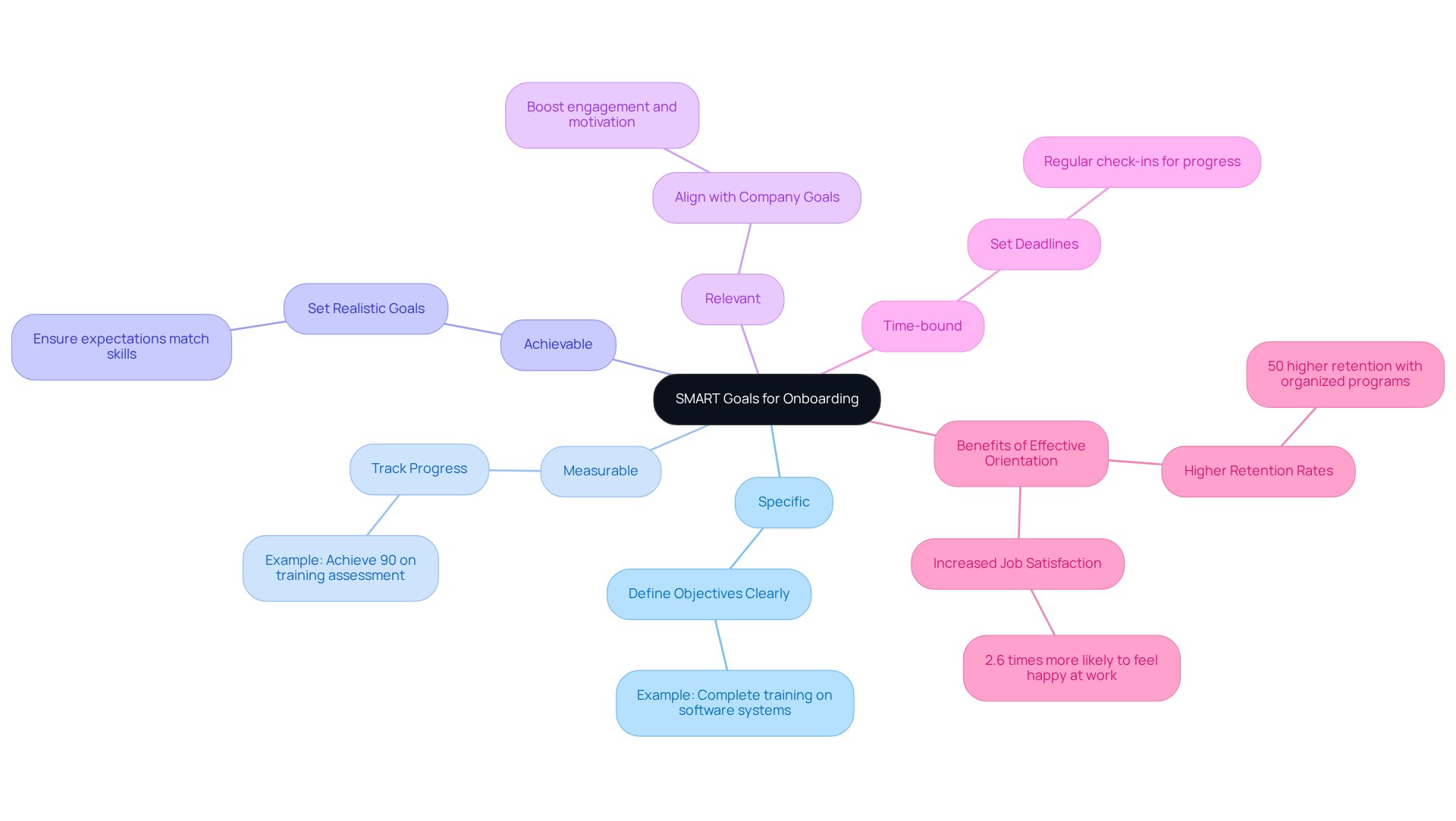
Streamlined Onboarding Processes
|
November 9, 2025
|
Create a New Hire 30-60-90 Plan for Effective Onboarding
Overview
You might be wondering how to create an effective 30-60-90 day onboarding plan for new hires. Well, let’s dive into it! This approach emphasizes structured phases that really help new employees integrate and boost their productivity.
So, what’s in it for you? These onboarding plans can increase retention rates by up to 82% and productivity boosts of over 70%! That’s pretty impressive, right? Plus, setting SMART goals is crucial to guide new hires through their transition smoothly.
By focusing on these structured phases, you’re not just helping your new team members feel welcome; you’re also setting them up for success from day one. And who doesn’t want that?
Now, think about your own onboarding process. Are there areas where you could improve? It’s all about creating a welcoming environment that encourages growth and engagement.
Key Highlights:
- The 30-60-90 day plan is divided into three phases: education (first 30 days), integration (next 30 days), and performance evaluation (final 30 days).
- Up to 20% of employee turnover occurs within the first 45 days, highlighting the need for effective orientation.
- 56% of new hires report that meeting a mentor in the first 90 days significantly boosts their productivity.
- Structured onboarding can increase new employee productivity by over 70% and retention rates by up to 82%.
- Regular cheque-ins during the onboarding process allow for timely feedback and adjustments, fostering continuous improvement.
- Creating a 30-60-90 day plan involves gathering input, defining objectives, setting milestones, creating a timeline, and reviewing progress.
- SMART goals (Specific, Measurable, Achievable, Relevant, Time-bound) are crucial for guiding new hires and ensuring accountability.
- Companies with organised orientation programmes see a 50% higher retention rate compared to those without.
Introduction
You might be wondering why creating a structured onboarding experience is so crucial these days. Well, as organizations strive to keep their talent and boost engagement right from the start, it’s become more important than ever. Enter the 30-60-90 day plan—a powerful tool that lays out a clear path for new hires as they embark on their journey in a company.
But how can this strategic approach really change the game for onboarding? How can it help new employees not just survive but truly thrive in their roles? Let’s explore the key components of a 30-60-90 day plan. It’s not just about the benefits; it’s about the vital role it plays in shaping a productive and committed workforce. So, let’s dive into this together!
Define the 30-60-90 Day Plan for New Hires
You might be wondering how a 30-60-90 day plan can really make a difference for new employees. Well, this strategic framework breaks down the induction process into three clear phases, each designed to help newcomers transition smoothly into their roles.
-
In the first 30 days, the focus is all about education and adjustment. This is when new staff get to know the company culture, policies, and their specific roles. It’s a crucial time—did you know that up to 20% of employee turnover happens within the first 45 days? That’s why a solid orientation is so important!
-
Now, let’s talk about the next 30 days. This is when things start to get exciting! New employees begin to integrate and contribute, using what they’ve learned and getting more involved with their teams. Building relationships is key here, and it’s great to know that 56% of new hires say that meeting a mentor just once in those first 90 days can really boost their productivity.
-
Finally, we reach the last 30 days, which are all about performance and evaluation. This is when new employees get assessed on their contributions and receive feedback to help them grow. Having a structured approach not only sets clear expectations but also ramps up productivity. In fact, organizations that have a formal orientation program see a whopping 50% increase in new employee efficiency!
HR experts really emphasize how important these organized induction plans are. An effective orientation process can boost retention by 82% and productivity by over 70%. So, by rolling out a 30-60-90 day plan, companies can set their new employees up for success, leading to a more engaged and committed workforce. And let’s not forget, with remote integration bringing its own set of challenges, addressing these can really enhance the experience for everyone involved.

Identify Benefits of a 30-60-90 Day Plan
A new hire 30 60 90 plan can really make a difference for both new hires and organizations when implemented. You might be wondering how this works, right? Let’s break it down:
-
Accelerated Learning: New employees can quickly get the hang of company processes and culture, which means they can start being productive sooner. Did you know that structured onboarding can boost productivity by over 70%? That’s huge! When organizations implement a solid new hire 30 60 90 plan, new hires can start contributing effectively within just a few weeks.
-
Clear Expectations: By setting specific goals for each phase, both managers and employees know exactly what’s expected. This clarity is super important because, believe it or not, 60% of employers don’t set milestones or goals with new hires. That can lead to a lot of confusion! Plus, 34% of employees haven’t even seen an orientation program at their workplace, which really shows the need for structured plans.
-
Enhanced Engagement: Having a structured introduction plan helps new hires feel like they belong and have a purpose. This can lead to higher employee satisfaction and retention. Companies that nail their induction processes can boost retention rates by as much as 82%! As BambooHR puts it, "The statistics leave no doubt: the integration process is a strategic investment."
-
Performance Tracking: Regular check-ins as part of the new hire 30 60 90 plan at the 30, 60, and 90-day marks allow for timely feedback and adjustments. This proactive approach not only builds confidence but also keeps new employees aligned with organizational goals, fostering a culture of continuous improvement.
So, integrating these elements into your induction process can lead to a more engaged workforce and significantly lower turnover costs. Did you know that turnover can cost up to 21% of an employee's yearly salary? That’s a big hit! The median turnover expense is about one-fifth of the position’s yearly salary, which really highlights the financial impact of not having a solid integration plan.

Outline Steps to Create the 30-60-90 Day Plan
Creating an effective new hire 30 60 90 plan is essential for onboarding. Let’s break it down into some simple steps that can really make a difference:
-
Gather Input: You might be wondering how to kick things off. Start by chatting with the new employee and key players like team leaders and HR. This way, you can gather insights on what’s expected in the role and the skills that matter most. It’s all about collaboration! Plus, using SowFlow’s documentation tools can make this input-gathering phase a breeze, helping you whip up user guides that reflect the onboarding process without the hassle of extra meetings.
-
Define Objectives: Now, let’s discuss what the new hire 30 60 90 plan should aim for in each phase. For the first 30 days, the focus should be on getting a grip on company policies, procedures, and culture. This sets a solid foundation for future success! With SowFlow, you can easily create and keep documentation that outlines these objectives, making sure they’re always accessible and up-to-date.
-
Set Milestones: Next up, break down each phase into measurable milestones. This not only helps you keep track of progress but also provides the new hire 30 60 90 plan with clear goals to strive for. Who doesn’t love a little motivation? SowFlow’s instant documentation solution can help standardize these milestones, making it easier to communicate expectations and celebrate achievements.
-
Create a Timeline: Speaking of organization, develop a timeline that aligns with the new employee’s start date. Each phase should have clear start and end dates. This structured approach helps manage expectations and keeps everything running smoothly. And with SowFlow, you can quickly update timelines as needed, so everyone stays in the loop about any changes.
-
Review and Adjust: Finally, don’t forget to schedule regular check-ins to evaluate progress and gather feedback. This iterative process allows you to tweak the plan based on how the new hire is doing and any bumps they might hit along the way. It’s all about fostering a supportive environment! With SowFlow, recording these check-ins and feedback is a cinch, ensuring that the training plan stays relevant and effective.
By integrating these steps, you’re not just improving the onboarding experience; you’re also following best practices seen in successful organizations. So, why not give it a shot? With SowFlow’s documentation capabilities, you can make sure new employees feel supported and ready to contribute right from day one!

Establish SMART Goals and Metrics for Success
To really make the most of your 30-60-90 day onboarding plan, you’ll want to set some SMART goals for each phase. You might be wondering what that means, right? Let’s break it down:
-
Specific: First off, you need to clearly define your objectives. For example, how about saying, 'Complete training on the company’s software systems'? This kind of clarity helps new employees understand exactly what they need to tackle right away.
-
Measurable: Next, think about how you can measure progress. Maybe you could aim for 'Achieve a score of 90% or higher on the software training assessment.' This gives you a solid way to evaluate how well the new employee is learning.
-
Achievable: It’s also important to set realistic goals that can actually be accomplished within the timeframe you’ve set. This way, you ensure that expectations match the new employee's skills and available resources.
-
Relevant: Make sure the goals are relevant to the new hire’s role and the company’s bigger picture. When goals align with what the company is all about, it really boosts engagement and motivation.
-
Time-bound: Finally, don’t forget to set deadlines for each goal. This adds a sense of urgency and accountability. Regular check-ins can help you keep track of progress and make any necessary adjustments along the way.
Now, here’s something to think about: research shows that companies with organized orientation programs see a 50% higher retention rate for new employees compared to those that don’t have them (source: Talmundo). Plus, effective orientation is linked to greater job satisfaction. In fact, employees who rate their onboarding experience as outstanding are 2.6 times more likely to feel happy at work (Gallup).
Leadership coaches like Allison Dunn remind us that "measurable objectives are crucial for guiding new hires toward success." This really drives home the point that clear metrics not only boost accountability but also help create a culture of continuous improvement. And let’s not forget, 63% of remote workers feel their training during orientation was lacking. So, it’s clear that organized integration is super important, especially in remote settings.
By putting these strategies into action, organizations can really enhance the onboarding experience, leading to better retention and productivity. So, what do you think? Ready to dive into improving your onboarding process?

Conclusion
You might be wondering how a 30-60-90 day plan can really change the game for new hires. Well, let me tell you, it’s a fantastic strategy that can seriously enhance the onboarding process! This structured approach not only helps employees transition smoothly but also aligns their early experiences with what the organization aims to achieve. By breaking down the onboarding journey into three clear phases, companies can make sure new hires get the guidance and support they need to hit the ground running from day one.
Now, let’s dive into some of the key benefits of adopting this plan. In those first 30 days, new employees really focus on soaking up the company culture and policies, which is super important for keeping them around. Then, in the next phase, it’s all about integration and building relationships. Finally, the last phase zeroes in on performance evaluation and feedback. These steps not only clarify what’s expected but also ramp up productivity and engagement, leading to higher retention rates and lower turnover costs.
So, what’s the takeaway here? Organizations that put a solid onboarding process at the forefront stand to gain a lot. By investing in a 30-60-90 day plan, companies can create a more engaged workforce, cut down on turnover, and boost overall productivity. As the workplace keeps evolving—especially with remote work becoming more common—embracing effective onboarding strategies is going to be key for long-term success. Taking the initiative to implement these practices not only benefits new hires but also strengthens the organization as a whole.
Frequently Asked Questions
What is a 30-60-90 day plan for new hires?
A 30-60-90 day plan is a strategic framework that breaks down the induction process for new employees into three phases: education and adjustment, integration and contribution, and performance and evaluation.
What happens during the first 30 days of the plan?
The first 30 days focus on education and adjustment, where new employees learn about the company culture, policies, and their specific roles. This phase is crucial as a significant portion of employee turnover occurs within the first 45 days.
What is the focus of the second 30 days?
The second 30 days involve integration and contribution, where new hires begin to apply what they've learned, get more involved with their teams, and build relationships. Meeting a mentor during this time can significantly boost their productivity.
What takes place in the final 30 days of the plan?
The final 30 days are centered around performance and evaluation. New employees are assessed on their contributions and receive feedback to support their growth, helping to set clear expectations and increase productivity.
How does a formal orientation program benefit new employees?
Organizations with a formal orientation program can see a 50% increase in new employee efficiency, and an effective orientation process can boost retention by 82% and productivity by over 70%.
Why is a 30-60-90 day plan important for companies?
A 30-60-90 day plan helps set new employees up for success, leading to a more engaged and committed workforce. It also addresses challenges associated with remote integration, enhancing the overall experience for new hires.
👍
What others are liking
5 Steps to outline your ideal documentation structure
5 MINS READ
Where to start the your journey of mapping out your ideal documentation structure, aligning it with the very heartbeat of your organization?
Defining a winning level of detail in your process
3 MINS READ
What is too much detail, and what is too little? This article described in that winning level detail about what detail is enough.





